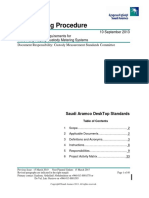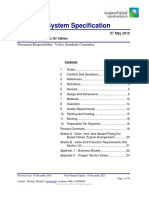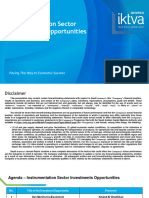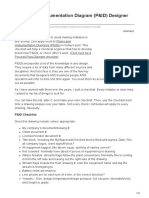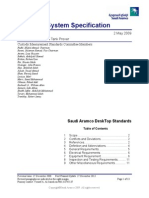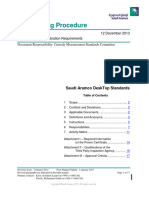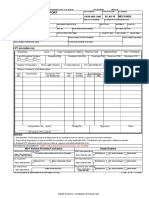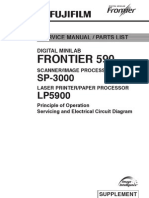Saep 22 PDF
Saep 22 PDF
Uploaded by
nadeem shaikhCopyright:
Available Formats
Saep 22 PDF
Saep 22 PDF
Uploaded by
nadeem shaikhOriginal Title
Copyright
Available Formats
Share this document
Did you find this document useful?
Is this content inappropriate?
Copyright:
Available Formats
Saep 22 PDF
Saep 22 PDF
Uploaded by
nadeem shaikhCopyright:
Available Formats
Engineering Procedure
SAEP-22 1 January 2018
Tank Calibration Requirements
Document Responsibility: Custody Measurement Standards Committee
Contents
1 Scope............................................................... 2
2 Conflicts and Deviations.................................. 2
3 Applicable Documents..................................... 2
4 Definitions and Acronyms................................ 3
5 Instructions.......................................................5
6 Responsibilities................................................ 7
7 Activity Matrix................................................. 10
Revision Summary............................................... 11
Attachment I - Required Information on
the Tank Capacity Table........................ 12
Attachment II - Qualifications of
the Third Party Inspection Agency......... 15
Previous Issue: 27 June 2016 Next Planned Update: 27 June 2019
Revised paragraphs are indicated in the right margin Page 1 of 15
Contacts: Al-Maatoug Maatoug Abdullah (maatouma) and Hassell, James Clyde (hasseljc)
©Saudi Aramco 2018. All rights reserved.
Document Responsibility: Custody Measurement Standards Committee SAEP-22
Issue Date: 1 January 2018
Next Planned Update: 27 June 2019 Tank Calibration Requirements
1 Scope
This procedure establishes the instructions and responsibilities for the calibration of
above-ground upright cylindrical tanks, horizontal tanks, spheres and spheroids used for
all Saudi Aramco royalty/custody tank gauging applications. This procedure is also
applicable to the inventory tanks that have the potential to be used for custody or
royalty measurement applications in case of the metering system failures.
Organizations for which responsibilities are specified include, but are not limited to:
The Proponent Organization
Saudi Aramco Project Management Team (SAPMT)
Process & Control Systems Department (P&CSD)
2 Conflicts and Deviations
2.1 Any conflicts between this document and other applicable Mandatory Saudi
Aramco Engineering Requirements (MSAERs) shall be addressed to the
EK&RD Coordinator.
2.2 Any deviation from the requirements herein shall follow internal company
procedure SAEP-302.
2.3 Direct all requests for interpretation of this procedure in writing to Chairman,
Custody Measurement Standards Committee for resolution. The chairman of the
Custody Measurement Standards Committee shall be solely responsible for
determining whether a proposed request meets the requirements of this procedure.
3 Applicable Documents
The procedures covered by this document shall comply with the latest edition of the
references listed below, unless otherwise noted:
3.1 Saudi Aramco Reference
Saudi Aramco Engineering Procedure
SAEP-302 Waiver of a Mandatory Saudi Aramco Engineering
Requirement
3.2 Industry Codes and Standards
American Petroleum Institute (API) Manual of Petroleum Measurement
Standards (MPMS)
Chapter 2.2A Measurement and Calibration of Upright Cylindrical
Tanks by the Manual Strapping Method
Saudi Aramco: Company General Use
Page 2 of 15
Document Responsibility: Custody Measurement Standards Committee SAEP-22
Issue Date: 1 January 2018
Next Planned Update: 27 June 2019 Tank Calibration Requirements
Chapter 2.2B Calibration of Upright Cylindrical Tanks using the
Optical-Reference Line Method
Chapter 2.2C Calibration of Upright Cylindrical Tanks using the
Optical-Triangulation Method
Chapter 2.2D Calibration of Upright Cylindrical Tanks using the
Internal Electro-optical Distance Ranging Method
Chapter 2.2E Calibration of Horizontal Cylindrical Tanks-
Part 1: Manual Methods
Chapter 2.2F Calibration of Horizontal Cylindrical Tanks-
Part 2: Internal Electro-Optical Distance-Ranging
Method
Standard 2552 Method for Measurement and Calibration of Spheres
and Spheroids
Standard 2555 Liquid Calibration of Tanks
4 Definitions and Acronyms
4.1 Definitions
Approve: Review and formal acceptance characterized by the signature of the
final authorizing individual or organization.
Capacity Table: A table often referred to as a tank capacity table or calibration
table, showing the capacities of or volumes in a tank for various liquid levels
measured from the reference gauge point.
Critical Zone: The region between initial and complete flotation of a floating
roof.
Custody Transfer Measurement: A specialized form of measurement that
provides quantity and quality information used for the physical and fiscal
documentation of a change in ownership and/or responsibility of hydrocarbon
commodities. This includes measurement of hydrocarbon liquid movements
(deliveries or receipts) between Saudi Aramco and its customers, suppliers, joint
ventures and transport contractors including VELA ships.
Customer: The party that takes ownership or responsibility of a hydrocarbon
commodity from Saudi Aramco.
Datum plate: A level metal plate located directly under the reference gauge
point to provide a fixed contact surface from which liquid depth measurement
can be made.
Saudi Aramco: Company General Use
Page 3 of 15
Document Responsibility: Custody Measurement Standards Committee SAEP-22
Issue Date: 1 January 2018
Next Planned Update: 27 June 2019 Tank Calibration Requirements
Deadwood: Deadwood refers to any object within the tank, including a floating
roof, which displaces liquid and reduces the capacity of the tank; also any
permanent appurtenances on the outside of the tank, such as cleanout boxes or
manholes, which increase the capacity of the tank. Deadwood is positive if it
increases tank capacity or negative if it decreases capacity.
External Floating Roof: A cover over an open top storage tank consisting of a
deck which rests upon the liquid being contained.
Internal Floating Roof: A cover within a fixed roof tank which rests upon the
petroleum liquid being contained.
Master Tape: A tape that is used for calibrating working tapes for tank
measurements and is identified with a report of calibration at 68°F (20°C) and a
specific tension designated by the National Institute of Standards and
Technology (NIST) or an equivalent international standard organization.
Recalibration: The process of re-establishing tank diameters through physical
measurements and of developing a new capacity table based on these tank
diameters.
Recomputation: The process of re-generating the capacity tables through soft
calculations, without repeating the field calibration measurements. It involves,
simply, updating or revising the capacity table using previously established tank
diameters.
Reference Gauge Height: The distance from the datum plate or tank bottom to
the reference gauge point.
Royalty Measurement: A specialized form of measurement that is used as the
basis for paying royalty to the Saudi Arabian Government.
SAP: The Saudi Aramco main system for enterprise resource management.
Spheres: A stationary liquid storage tank, supported on columns so that the
entire tank shall be aboveground.
Spheroid: A stationary liquid storage tank having a shell of double curvature.
Any horizontal cross-section is a series of circular arcs.
Strapping: The measurement of the external circumference of a vertical or
horizontal cylindrical tank by stretching a steel tape around each course of the
tank's plates and recording the measurement.
Tank Calibration: The process of determining the capacity of a tank through
field measurements.
Saudi Aramco: Company General Use
Page 4 of 15
Document Responsibility: Custody Measurement Standards Committee SAEP-22
Issue Date: 1 January 2018
Next Planned Update: 27 June 2019 Tank Calibration Requirements
Third Party Inspection Agency: An independent inspection agency whose
function is to conduct an unbiased inspection of certain systems, equipment,
materials, etc., against a set of standards, guidelines or procedures. For purposes
of this SAEP, the Third Party Inspector has particular knowledge of and
experience of conducting tank calibration in accordance with industry custody
measurement standards and procedures.
4.2 Abbreviations
API American Petroleum Institute
CMU Custody Measurement Unit of Process & Control Systems
Department
EODR Electro Optical Distance Ranging
ORLM Optical Reference Line Method
MPMS Manual of Petroleum Measurement Standards
P&CSD Process & Control Systems Department
SA Saudi Aramco
SAEP Saudi Aramco Engineering Procedure
SAES Saudi Aramco Engineering Standard
SAMSS Saudi Aramco Material Specification
SAP Systems Application Programming
SASD Saudi Aramco Engineering Standard Drawing
5 Instructions
5.1 General
This procedure shall be used in conjunction with existing international standards
and is not intended to replace the standards referred to in Section 3 above.
The reference temperature for all tank capacity tables shall be 60°F for
Refineries, Terminals, Gas Plants, and 15°C for Distribution Operations.
5.2 Calibration/Re-calibration Frequencies
All new tanks/vessels used for custody transfer measurement must undergo
calibration prior to being put in service.
All tanks/vessels must be recalibrated in conjunction with Testing and
Inspection (T&I), or when a major repair is done for tank bottom.
Saudi Aramco: Company General Use
Page 5 of 15
Document Responsibility: Custody Measurement Standards Committee SAEP-22
Issue Date: 1 January 2018
Next Planned Update: 27 June 2019 Tank Calibration Requirements
The upright cylindrical tank shall be recalibrated in accordance with
API MPMS Chapter 2.2A, Appendix A. Use a criteria of 0.02% or more change
in volume detected to invoke this appendix requirement.
5.3 Precalibration Preparations
Prior to calibration, the upright cylindrical tanks, horizontal tanks, spheres and
spheroids must have been filled to 95% of their design operating capacity for a
minimum period of 24 hours with a liquid at least as dense as the product they
will normally store.
Note: This requirement is considered met if the tank/vessel has been already hydro-
tested.
5.4 Recomputation Requirements
The capacity table of horizontal tanks, spheres and spheroids must be
recomputed if variation in product operating temperatures and temperature
assumed during calibration is greater than 11°C (20°F) or the variations in the
product's calibration specific gravity and operating specific gravity are greater
than 20%.
Note: Variations in the product's calibration specific gravity and operating specific
gravity greater than 20% will require a recomputation of the table, due to the
hydrostatic head effect expansion on tanks/vessels.
Floating roof correction table requires recomputation when any variation in the
roof's weight, due to repairs or modifications, results in a change in the roof
deadweight that altered the tank predetermined volume by 0.02% or more.
Note: While recalibration involves reestablishing tank diameters through standard
calibration methods and developing new tank capacity tables for custody and
non-custody transfers, recomputation, involves simply updating or revising the
capacity table using previously established tank diameters.
5.5 Acceptable Calibration Technologies
Following is a list of the calibration technologies acceptable for tank/vessel
calibrations along with the reference standard the methods' implementation
should comply to. The methods are arranged in the order of priority, based on
the most efficient means of calibration for a given set of conditions.
(1) Internal Electro Optical Distance Ranging Method (EODR),
API Chapter 2.2D
(2) Internal Electro Optical Distance Ranging Method (EODR),
API Chapter 2.2F
(3) Optical Reference Line Method (ORLM), API Chapter 2.2B
Saudi Aramco: Company General Use
Page 6 of 15
Document Responsibility: Custody Measurement Standards Committee SAEP-22
Issue Date: 1 January 2018
Next Planned Update: 27 June 2019 Tank Calibration Requirements
(4) Manual Strapping Method (Strapping), API Chapter 2.2A
(5) Optical Triangulation Method, API Chapter 2.2C
(6) Manual Methods, API Chapter 2.2E
(7) Liquid Calibration, API 2555
(8) Method for Measurement and Calibration of Spheres and Spheroids,
API STD 2552
Note: All these methods essentially provide alternate techniques for measuring tank
diameters. While manual strapping is limited to external calibrations, the
remaining methods can be used either externally or internally.
5.6 Technology Selection Guidelines
a. The application of the EODR shall be limited to tanks/vessels that are
greater than 5 meters in diameter.
b. The application of liquid calibration (API 2555) shall be limited to
tanks/vessels that are smaller than 5 meters in diameter.
c. If a tank/vessel is insulated, it should be calibrated internally.
d. External and internal EODR shall be used for all tanks/vessels that are
greater than 5 meters in diameter with no insulation.
e. Either Internal or external ORLM shall be used for floating roof tanks.
f. External ORLM can be used for fixed roof tanks with no insulation and
having not more than a single wind girder.
g. If the tank has multiple external wind girders, it should be calibrated either
by external/internal EODR or internal ORLM.
h. Tank bottom shall be calibrated by a physical survey. In a physical survey,
bottom elevations shall be sighted along radii every 45 degrees. Along
these radii, elevations should be obtained at equally spaced intervals not
more than 10 feet (3 meters) from the tank's center to its shell. Liquid
calibration method is permitted to be used whenever the tank contains
irregular shaped deadwood (e.g., steam coils, etc.).
i. Spheres and spheroids shall be calibrated in accordance with API STD 2552,
Method for Measurement and Calibration of Spheres and Spheroids.
6 Responsibilities
The Saudi Aramco organizations with tank/vessels calibration responsibilities shall
ensure that their personnel become familiar with this SAEP.
Saudi Aramco: Company General Use
Page 7 of 15
Document Responsibility: Custody Measurement Standards Committee SAEP-22
Issue Date: 1 January 2018
Next Planned Update: 27 June 2019 Tank Calibration Requirements
6.1 Saudi Aramco Project Management Team (SAPMT)
a. Initiate calibration request for new tanks/vessels.
b. Inform CMU of the calibration of new tanks only if is used for royalty
transfer.
c. Request list of Approved Third Party Inspection Agencies from CMU.
d. Contract tank calibrations to an approved third-party inspection agency.
e. Inform the Proponent to witness the calibration process.
f. Obtain the capacity tables from the third-party inspection agency.
g. Request CMU's review for capacity tables of new royalty tanks.
h. Provide two hardcopy and two electronic tables in US customary units
and/or (based on application requirement) SI units of the final approved
calibration calculation and the capacity table to the Proponent.
i. Close the activity.
6.2 The Proponent Organization
a. Initiate requests for in-service tanks/vessels per the frequency requirements
set forth in Section 5.2 above.
b. Inform CMU of the calibration of new tanks if it is used for royalty transfer
applications,
c. Request list of the approved Third Party Inspection Agencies,
d. Contract tank calibrations to an approved third-party inspection agency,
e. Provide the operating data (operating temperature, density at operating
temperature, operating pressure) to the third-party inspection agency,
f. Ensure the equipment used has been calibrated and has valid certificates
that are traceable to National Institute of Standard and Technology (NIST)
or other approved standards organization,
g. Witness the field calibration process and ensure that the third-party
inspection agency is performing the tank/vessel calibration calculations in
accordance API MPMS Chapter 2.2A and API STD 2552, including, but
not limited to, the following capacity table correction factors,
i. Master tape corrections
ii. Working tape correction
iii. Tape rise correction
iv. Tank shell temperature expansion correction
Saudi Aramco: Company General Use
Page 8 of 15
Document Responsibility: Custody Measurement Standards Committee SAEP-22
Issue Date: 1 January 2018
Next Planned Update: 27 June 2019 Tank Calibration Requirements
v. Hydrostatic head effect correction
vi. Tilt correction
vii. Floating roof gravity adjustment
h. Consult with CMU if a technical inquiry about the calibration and/or
documentation process cannot be resolved internally.
i. Review the draft calibration calculations.
j. Review the produced capacity tables and make sure they comply with the
requirements in Attachment I.
k. Submit the capacity tables for the calibration of the new tanks to the SAPMT.
l. Submit initial capacity tables of new royalty tanks only to CMU for review.
m. Maintain two hardcopy and two electronic tables in US customary units
and/or (based on application requirement) SI units of the final approved
calibration calculation and the capacity table to the proponent.
n. Update the SAP Tank Gauging System with the new approved capacity
table, if applicable.
o. Inform the SAPMT of the completion of the tank calibration.
p. Commission the tank.
q. Close the activity.
6.3 Process & Control Systems Department (P&CSD)
The Process & Control Systems Department/Custody Measurement Unit (CMU)
is responsible for providing technical assistance to the Proponent(s) on matters
pertaining to tank calibrations. Specific responsibilities of CMU are
summarized below:
a. Review the qualifications of the third-party inspection agencies and make
sure they meet all of the requirements detailed in Attachment II.
b. Maintain the list of Approved Third Party Inspection Agencies.
c. Submit the list of the Approved Third Party Inspection Agencies to the
SAPMT and the Proponent upon request.
d. Upon request from the proponent, provide consultation if a technical
inquiry about the calibration and/or documentation process cannot be
resolved internally.
e. Review initial capacity tables of new royalty tanks only.
Saudi Aramco: Company General Use
Page 9 of 15
Document Responsibility: Custody Measurement Standards Committee SAEP-22
Issue Date: 1 January 2018
Next Planned Update: 27 June 2019 Tank Calibration Requirements
7 Activity Matrix
The following matrix summarizes the general sequence of activities and corresponding
responsible organizations for calibrating tanks. Detailed requirements for each
organization are specified in Section 6.
Step Activity/Work Item Perform
Review the qualifications of the Third Party Inspection
1 Agencies and make sure they meet all of the requirements CMU
detailed in Attachment II.
Maintaining the list of Approved Third Party Inspection
2 CMU
Agencies.
3 Initiating request for tank/vessel calibration. SAPMT/Proponent(1)
4 Informing CMU of the calibration of new royalty tanks. SAPMT/Proponent
5 Request list of Approved Third Party Inspection Agencies. SAPMT/Proponent
Submitting list of Approved Third Party Inspection Agencies
6 CMU
to SAPMT and Proponent upon request.
Contracting tank calibrations to an approved Third Party
7 SAPMT/Proponent
Inspection agency.
Third Party Inspection
8 Selecting the Method of Calibration.
Agency
9 Informing the Proponent to witness the calibration process. SAPMT
Providing the operating data to the third-party inspection
10 Proponent
agency.
Ensuring the equipment used has been calibrated traceable
11 to National Institute of Standard and Technology (NIST) or Proponent
other approved standards organizations.
Third Party Inspection
12 Conducting the calibration in accordance to Section 5.
Agency
Third Party Inspection
13 Performing tank/vessel calibration calculations.
Agency
14 Witness the field calibration process. Proponent
Consult with CMU if a technical inquiry about the calibration
15 Proponent
and/or documentation process cannot be resolved internally.
16 Reviewing the draft calibration calculations. Proponent
Submit the capacity tables for the calibration of the new tanks
17 Proponent
to the SAPMT.
Submit the initial capacity tables of new royalty tanks only to
18 Proponent
CMU for review.
19 Review the initial capacity tables for new royalty tanks only. CMU
Providing two hardcopy and two electronic tables in US
21 Customary units and metric units of the final approved SAPMT/Proponent
calibration calculation and the capacity table.
Updating SAP Tank Gauging and RTG Tank Master Systems
21 Proponent
with the new approved capacity table.
Saudi Aramco: Company General Use
Page 10 of 15
Document Responsibility: Custody Measurement Standards Committee SAEP-22
Issue Date: 1 January 2018
Next Planned Update: 27 June 2019 Tank Calibration Requirements
Step Activity/Work Item Perform
22 Inform the SAPMT of the completion of the tank calibration. Proponent
23 Commissioning the tank. Proponent
24 Close the activity. SAPMT/Proponent
Note:
(1) SAPMT initiates calibration request for new tanks/vessels. The Proponent initiates calibration request
for tanks/vessels in-service per the frequency requirements set forth in Section 5 above. For BI-1900,
the proponent will assume the responsibilities of SAPMT.
Revision Summary
22 May 2011 Revised the "Next Planned Update". Reaffirmed the contents of the document, and
reissued with minor changes.
3 September 2013 Editorial revision to change the primary contacts.
27 June 2016 Revised the Next Planned Update, reaffirmed the contents of the document, and reissued
as major revision.
1 January 2018 Editorial revision to modify Section 2.
Saudi Aramco: Company General Use
Page 11 of 15
Document Responsibility: Custody Measurement Standards Committee SAEP-22
Issue Date: 1 January 2018
Next Planned Update: 27 June 2019 Tank Calibration Requirements
Attachment I - Required Information on the Tank Capacity Table
The final capacity table should contain the following minimum documentation details:
1. Tank Identification
a. The site or installation tank number
b. Location Titled with “Saudi Arabian Oil Company”
c. The type of tank in service
d. The name of the plant, owner or operator
e. The name and address of the calibration authority or company which carried
out the calibration.
2. Product Information
The product name and density of the liquid stored in the tank when in service and
used in the computation of the tank capacity tables.
3. Operational Details
a. The standard temperature (60°F for U.S. Customary, or 15°C for metric tables)
for which the tank capacity table has been calculated.
b. Operating temperature and pressure
c. Table type (innage or ullage)
4. Traceability and Tracking Details
a. The date a new tank was first calibrated
b. The date an old tank was recalibrated
c. Calibration agent reference document number
d. The date the tank was recomputed, and the method used for recomputation
e. The date of the calibration along with specific references to the method
adopted in calibrating the tank bottom
f. Page number
g. Reference to the standard on which the calibration is based
h. The third-party inspection agency shall sign and stamp each page of the
certificate.
Saudi Aramco: Company General Use
Page 12 of 15
Document Responsibility: Custody Measurement Standards Committee SAEP-22
Issue Date: 1 January 2018
Next Planned Update: 27 June 2019 Tank Calibration Requirements
5. Tank Dimensions
a. The nominal height and diameter of the tank
b. Description of the tank bottom type, along with the method used to determine
the bottom volume
c. Integrated deadwood, accurately accounted for as to location and volume, and
included as an attachment
d. Note on capacity table that the volume below the striking plate is included in
the first measurement
e. The shell height, is measured as the vertical distance between the bottom of
the bottom angle and top of the top angle and measured near the reference
gauge hatch
f. Reference height measurement point locations shall be clearly identified on
tank capacity tables
g. The height of the datum-points(s) with reference to the junction of the tank
shell and bottom plating
h. If an automatic gauging system is installed, the height of the gauge datum
point with reference to the junction of the tank shell and bottom plating
i. Maximum fill height
j. Safe fill height specified by the tank owner
k. The amount of tilt in shell height is measured and recorded.
l. Height of the striking point (datum plate) from the tank bottom plate
m. The decimal (fraction) average volume for each strapping page.
6. Floating Roof Information
a. The allowance for the roof is to be treated as deadwood and incorporated in
the tank capacity table directly, not as a separate attachment
b. The density of the liquid for which the roof has been calculated shall be
recorded on the table directly
c. The apparent mass in air of the roof and accessories
d. The displacement volume of the roof and the floating roof correction factor
method statement
e. A defined level (Level A), with the distance above the dip point designating
where the roof is at rest
f. A defined level (Level B), with the distance when the roof is just fully floating
in the lowest-density liquid to be contained in the tank
Saudi Aramco: Company General Use
Page 13 of 15
Document Responsibility: Custody Measurement Standards Committee SAEP-22
Issue Date: 1 January 2018
Next Planned Update: 27 June 2019 Tank Calibration Requirements
g. The part of the capacity table between Level A and Level B is marked as “Not
Accurate”
h. Critical zones shall be identified within the table
i. The range where floating roof adjustment not to be performed.
7. Tank Shell Correction
a. A shell temperature expansion factor table is to be developed in increments of
5°F or 3°C and included as an attachment to the capacity table for a specific
operating range.
b. Include the equation for determining the shell temperature.
Saudi Aramco: Company General Use
Page 14 of 15
Document Responsibility: Custody Measurement Standards Committee SAEP-22
Issue Date: 1 January 2018
Next Planned Update: 27 June 2019 Tank Calibration Requirements
Attachment II - Qualifications of the Third Party Inspection Agency
The third-party inspection agency shall meet all of the following requirements:
1. The agency has provided similar services for a minimum of 3 years. It shall submit
a list of companies for which it has provided similar calibration services over the
preceding 3 years.
2. The agency's personnel performing the field measurements and calculations must
have a minimum of one year experience with the application of the API tank/vessel
calibration standards. Experience shall be documented by submittal of resume and
verifiable work histories.
3. The agency shall have written procedures which meet the requirements of API
tank/vessel calibration standards. It shall submit the written procedures for review.
4. The agency shall have equipment as specified in API MPMS Chapter 2.2. It shall
submit a list of the equipment it intends to use along with corresponding valid
calibration certificates.
5. The agency shall demonstrate it is ISO-certified and that it is actively administering
a quality assurance program. It shall submit a copy of its ISO certification and his
quality assurance program details for review.
6. The agency shall demonstrate that it is capable of performing the tank/vessel
calibration calculations. It shall provide a minimum of two samples of previous
calibration results, including field data and all calculations.
7. The agency shall provide financial and insurance documentations as deemed
necessary by the Contracting Unit to ensure he has adequate liability coverage for
damages done to Saudi Aramco facilities.
Saudi Aramco: Company General Use
Page 15 of 15
You might also like
- i1000SR Service Manual PDFDocument1,086 pagesi1000SR Service Manual PDFALONSO GARCIA71% (7)
- Saes R 004Document8 pagesSaes R 004nadeem shaikh100% (1)
- Saep 319Document66 pagesSaep 319AbdullahNo ratings yet
- Saep 21Document29 pagesSaep 21brecht1980No ratings yet
- SAEP 1610 (Oct 2017)Document9 pagesSAEP 1610 (Oct 2017)nadeem shaikhNo ratings yet
- Sabp L 002Document27 pagesSabp L 002yoonchankim0911100% (1)
- 34 Samss 118 PDFDocument9 pages34 Samss 118 PDFCherukunnon JubuNo ratings yet
- 04 Samss 055Document42 pages04 Samss 055nadeem shaikh100% (1)
- Saes S 040Document22 pagesSaes S 040nadeem shaikhNo ratings yet
- Saes S 007Document17 pagesSaes S 007nadeem shaikhNo ratings yet
- Ata 28 Fuel SystemDocument243 pagesAta 28 Fuel SystemAndres Parra Navarro100% (4)
- Going The Distance: Solids Level Measurement With RadarDocument19 pagesGoing The Distance: Solids Level Measurement With RadarMomentum Press100% (2)
- Saep 50Document40 pagesSaep 50syed jeelani ahmed100% (1)
- 34-SAMSS-321 Radar Tank Gaauging Systems For Royalty Custody Measurement of Hydrocarbon LiquidsDocument34 pages34-SAMSS-321 Radar Tank Gaauging Systems For Royalty Custody Measurement of Hydrocarbon Liquidsryann mananquilNo ratings yet
- 34 Samss 119Document15 pages34 Samss 119naruto256No ratings yet
- 34 Samss 112Document14 pages34 Samss 112naruto256No ratings yet
- 34 Samss 114Document20 pages34 Samss 114Moustafa BayoumiNo ratings yet
- Saep 57 PDFDocument30 pagesSaep 57 PDFRami ElloumiNo ratings yet
- Saep 1131 PDFDocument16 pagesSaep 1131 PDFbalajiNo ratings yet
- 34 Samss 117Document9 pages34 Samss 117Cherukunnon JubuNo ratings yet
- 31-SAMSS-006 - 2 July 2019 ERDocument15 pages31-SAMSS-006 - 2 July 2019 ERjulius100% (1)
- Saep 380 PDFDocument10 pagesSaep 380 PDFbassamNo ratings yet
- API & Asme PSV, PZV Orifice AreaDocument2 pagesAPI & Asme PSV, PZV Orifice AreaUmmer BavaNo ratings yet
- PECEICPF550006A2Document40 pagesPECEICPF550006A2RuddyNo ratings yet
- 04-Samss-35 ValvesDocument28 pages04-Samss-35 ValvesNabeel AKNo ratings yet
- InstrumentationDocument56 pagesInstrumentationMohammed IrfanNo ratings yet
- Materials System SpecificationDocument12 pagesMaterials System SpecificationGOSP3 QC Mechanical100% (1)
- Saes L 130Document5 pagesSaes L 130Ahmed Kabel100% (1)
- Api MPMS E&pDocument44 pagesApi MPMS E&pJefferson Flórez ToroNo ratings yet
- 34 Samss 718Document14 pages34 Samss 718naruto256No ratings yet
- 32 Samss 027Document30 pages32 Samss 027naruto256No ratings yet
- Saep 1144Document23 pagesSaep 1144Amit shahNo ratings yet
- Saes L 420Document11 pagesSaes L 420Abdullah RiazNo ratings yet
- Enquiry ValveDocument4 pagesEnquiry ValvePradnyesh DivekarNo ratings yet
- Saes A 005 PDFDocument32 pagesSaes A 005 PDFAdnanAtifNo ratings yet
- Gate, Globe and Check Valves (Amendments/Supplements To Iso 15761)Document13 pagesGate, Globe and Check Valves (Amendments/Supplements To Iso 15761)윤규섭100% (1)
- Saes A 005Document32 pagesSaes A 005hyderabad100% (1)
- Piping and Instrumentation Diagram PID Designer ChecklistDocument4 pagesPiping and Instrumentation Diagram PID Designer ChecklistHelena MartinsNo ratings yet
- Saes A 011Document25 pagesSaes A 011Abdul BasithNo ratings yet
- Saudi Aramco Inspection ChecklistDocument3 pagesSaudi Aramco Inspection ChecklistDilshad AhemadNo ratings yet
- 00 Saip 75 PDFDocument64 pages00 Saip 75 PDFluke luckyNo ratings yet
- SATR-A-2001V Rev 6 Pressure Test Report (Valve Inspection & Field Report)Document2 pagesSATR-A-2001V Rev 6 Pressure Test Report (Valve Inspection & Field Report)Ahdal NoushadNo ratings yet
- 34 Samss 711 PDFDocument26 pages34 Samss 711 PDFFlorin Daniel AnghelNo ratings yet
- Saep 308Document19 pagesSaep 308Demac SaudNo ratings yet
- Saes B 069Document9 pagesSaes B 069Cane CirpoNo ratings yet
- 77-103 - 2012 Globe ValvesDocument13 pages77-103 - 2012 Globe ValvespradeepNo ratings yet
- Saudi Aramco Inspection ChecklistDocument8 pagesSaudi Aramco Inspection Checklistnisha_khan0% (1)
- 04 Samss 035Document28 pages04 Samss 035SamiNo ratings yet
- Saic A 2013Document6 pagesSaic A 2013jerinNo ratings yet
- SAES-W-016 Welding of Special Corrosion-Resistant Materials Issued On Jan 01, 2018 Till Nov 10, 2019Document14 pagesSAES-W-016 Welding of Special Corrosion-Resistant Materials Issued On Jan 01, 2018 Till Nov 10, 2019DipuNo ratings yet
- 34 Samss 846Document37 pages34 Samss 846Artur UzeevNo ratings yet
- 34 Samss 711Document26 pages34 Samss 711Mohamed Ahmed MaherNo ratings yet
- 04 Samss 002 PDFDocument8 pages04 Samss 002 PDFnadeem shaikhNo ratings yet
- SAIC-L-2042 Rev 6 Field Hydrostatic Testing of Isolation ValvesDocument6 pagesSAIC-L-2042 Rev 6 Field Hydrostatic Testing of Isolation ValvesAhdal NoushadNo ratings yet
- 34 Samss 122Document13 pages34 Samss 122naruto256No ratings yet
- 00 Saip 06Document4 pages00 Saip 06Selvakpm06No ratings yet
- Saic A 2011Document5 pagesSaic A 2011Anonymous 4e7GNjzGWNo ratings yet
- 34 Samss 510Document30 pages34 Samss 510mannem88No ratings yet
- 32 Samss 031Document7 pages32 Samss 031naruto256No ratings yet
- Saep 22 PDFDocument15 pagesSaep 22 PDFShaik Mudassar NazarNo ratings yet
- Engineering Procedure: SAEP-22 4 April 2006 Tank Calibration Requirements Custody Measurement Standards Committee MembersDocument14 pagesEngineering Procedure: SAEP-22 4 April 2006 Tank Calibration Requirements Custody Measurement Standards Committee Membersmohammed harrisNo ratings yet
- Saep 28Document27 pagesSaep 28Abdul Ahad LoneNo ratings yet
- Sae 44Document26 pagesSae 44Anonymous 4IpmN7OnNo ratings yet
- Saep 36Document17 pagesSaep 36BilalNo ratings yet
- SAEP-28 EditorialDocument28 pagesSAEP-28 EditorialAbu Anas M.SalaheldinNo ratings yet
- Sabp J 102Document16 pagesSabp J 102mohamed salahNo ratings yet
- Saudi Aramco Test Report: Assessment of Ultrasonic ResultsDocument4 pagesSaudi Aramco Test Report: Assessment of Ultrasonic Resultsnadeem shaikhNo ratings yet
- Saudi Aramco Test Report: Ultraviolet (UV) Light Intensity Log 24-Jul-18 NDEDocument2 pagesSaudi Aramco Test Report: Ultraviolet (UV) Light Intensity Log 24-Jul-18 NDEnadeem shaikhNo ratings yet
- Saudi Aramco Test Report: Ultrasonic Test Report (Weld Overlay UT Examination) SATR-NDE-2006 24-Jul-18 NdeDocument9 pagesSaudi Aramco Test Report: Ultrasonic Test Report (Weld Overlay UT Examination) SATR-NDE-2006 24-Jul-18 Ndenadeem shaikhNo ratings yet
- Saudi Aramco Test Report: Ultrasonic Test Report - TKY Joints SATR-NDE-2005 24-Jul-18 NdeDocument3 pagesSaudi Aramco Test Report: Ultrasonic Test Report - TKY Joints SATR-NDE-2005 24-Jul-18 Ndenadeem shaikhNo ratings yet
- Saudi Aramco Test Report: Radiography Interpretation (To Be Filled in by The Responsible RTFI)Document4 pagesSaudi Aramco Test Report: Radiography Interpretation (To Be Filled in by The Responsible RTFI)nadeem shaikhNo ratings yet
- Saudi Aramco Test Report: Ultrasonic Testing (SAEP-311 Hot Tap/Tie In) Report 24-Jul-18 NDEDocument1 pageSaudi Aramco Test Report: Ultrasonic Testing (SAEP-311 Hot Tap/Tie In) Report 24-Jul-18 NDEnadeem shaikhNo ratings yet
- MPT Procedure No:: Saudi Aramco Test ReportDocument2 pagesMPT Procedure No:: Saudi Aramco Test Reportnadeem shaikhNo ratings yet
- Satr Nde 2002Document1 pageSatr Nde 2002nadeem shaikhNo ratings yet
- Saes Q 004Document25 pagesSaes Q 004nadeem shaikhNo ratings yet
- SAUDI ARAMCO ID/PIEU-24-July-2018 - REV.2018.06.00 (Standards Cutoff - June 30,2018)Document2 pagesSAUDI ARAMCO ID/PIEU-24-July-2018 - REV.2018.06.00 (Standards Cutoff - June 30,2018)nadeem shaikhNo ratings yet
- Satr A 2010Document2 pagesSatr A 2010nadeem shaikhNo ratings yet
- Saes S 010Document28 pagesSaes S 010nadeem shaikh0% (1)
- Saes S 020Document33 pagesSaes S 020nadeem shaikhNo ratings yet
- Saep 306Document15 pagesSaep 306nadeem shaikh100% (1)
- Saes T 101Document6 pagesSaes T 101nadeem shaikhNo ratings yet
- Saes P 121Document19 pagesSaes P 121nadeem shaikhNo ratings yet
- Tank GaugingDocument61 pagesTank Gaugingatmoko2100% (3)
- Knife Gate Valve Selection Guide 10.00 15Document6 pagesKnife Gate Valve Selection Guide 10.00 15dsyashankaNo ratings yet
- Ultrasonic Measurement Time-of-Flight Prosonic FMU44Document4 pagesUltrasonic Measurement Time-of-Flight Prosonic FMU44David Hudson SouzaNo ratings yet
- Triton 1000 STPDocument48 pagesTriton 1000 STPbevandcostabuisnessNo ratings yet
- Compact List - Emerson AutomationDocument22 pagesCompact List - Emerson AutomationRafael GustavoNo ratings yet
- Ti280fen PDFDocument12 pagesTi280fen PDFhasanien salahNo ratings yet
- Labaratory Report.Document6 pagesLabaratory Report.Mary Grace SecondesNo ratings yet
- HYSYS Dynamics, SoftwareDocument23 pagesHYSYS Dynamics, SoftwareShamsMohdNo ratings yet
- GemsSensors MasterCatalogDocument422 pagesGemsSensors MasterCatalogJesus RodriguezNo ratings yet
- Level Transmitter: DescriptionDocument2 pagesLevel Transmitter: DescriptionvitovasquezNo ratings yet
- Parts List FR590Document134 pagesParts List FR590Jorge Gallardo ParedesNo ratings yet
- CHE501V1 6TALANDRONlevelsensorDocument8 pagesCHE501V1 6TALANDRONlevelsensorClaire Therese TalandronNo ratings yet
- Krohne Marshall Product OverviewDocument56 pagesKrohne Marshall Product Overviewzakir84md3639No ratings yet
- نسخة Advanced Stationary Asphalt Batching Plant ALBDocument9 pagesنسخة Advanced Stationary Asphalt Batching Plant ALBstamhaythamNo ratings yet
- Fuel System: SectionDocument12 pagesFuel System: SectionYB MOTOR Nissan - Datsun SpecialistNo ratings yet
- Endress-Hauser Micropilot FMR52 ENDocument4 pagesEndress-Hauser Micropilot FMR52 ENBryan NavarreteNo ratings yet
- Vegapuls 31: Two-Wire 4 20 mA/HART Radar Sensor For Continuous Level MeasurementDocument2 pagesVegapuls 31: Two-Wire 4 20 mA/HART Radar Sensor For Continuous Level MeasurementShrikant KambleNo ratings yet
- Enr - Tech - 3mi3 - Measurements and IntrumentationDocument6 pagesEnr - Tech - 3mi3 - Measurements and Intrumentationsinghjobanjit99No ratings yet
- Field InstrumentsDocument10 pagesField InstrumentsxentrerNo ratings yet
- Introduction To Instrumentation and Process Control: TrainingDocument3 pagesIntroduction To Instrumentation and Process Control: TrainingNavin SabbanNo ratings yet
- Sensor de Nivel Ultrasonico - IngDocument9 pagesSensor de Nivel Ultrasonico - IngMaxwell MazariegosNo ratings yet
- Fuel Tank and LinesDocument22 pagesFuel Tank and LinesSean RameyNo ratings yet
- Polydos 412A: Polymer Preparation SystemDocument32 pagesPolydos 412A: Polymer Preparation SystemreinpolyNo ratings yet
- Project 12Document7 pagesProject 12Rohan lallNo ratings yet
- Dokumen - Tips Pdvsa K 303Document32 pagesDokumen - Tips Pdvsa K 303ariasdelarossaNo ratings yet
- DP Transmitter Interface Level Measurement Principle, Limitations, Selection, Installation, Design & CalibrationDocument12 pagesDP Transmitter Interface Level Measurement Principle, Limitations, Selection, Installation, Design & Calibrationsubbarao100% (1)
- Industrial Pressure Transmitters Type S-10 - Vacuum To 60,000 PSIDocument4 pagesIndustrial Pressure Transmitters Type S-10 - Vacuum To 60,000 PSItaufanwNo ratings yet












